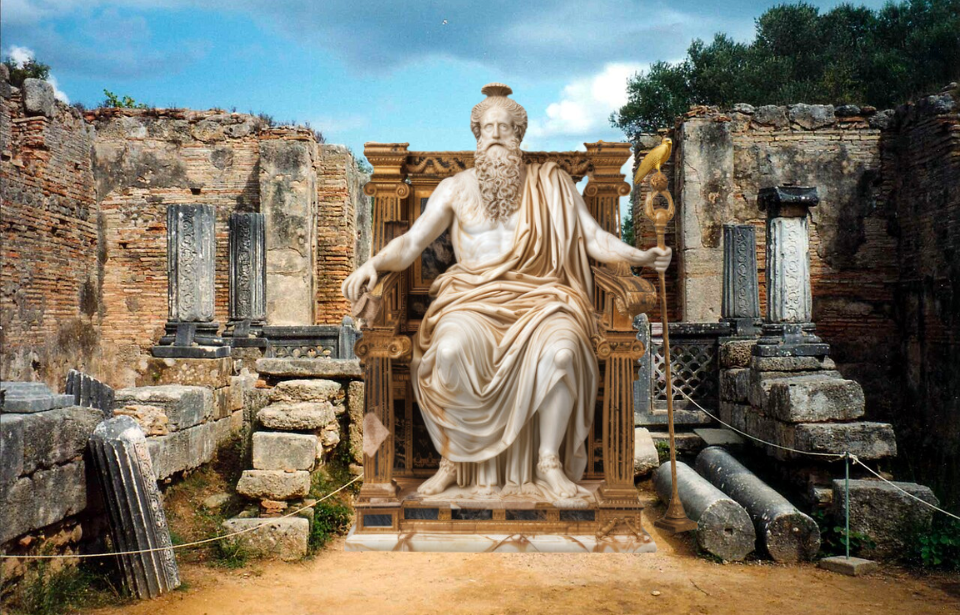Delving into the ancient world, the Statue of Zeus at Olympia stands as a monumental testament to the grandeur of Greek artistry and religious devotion. Crafted in the 5th century BC by the renowned sculptor Phidias, this colossal figure was not merely an artistic marvel but also a symbol of the might and majesty of Zeus, the king of the Olympian gods. Nestled within the Temple of Zeus at the heart of Olympia, the statue was a centerpiece of the ancient Olympic Games, drawing visitors from across the Greek world who came to pay homage and marvel at its splendor.
Historical context and creation of the Statue of Zeus at Olympia
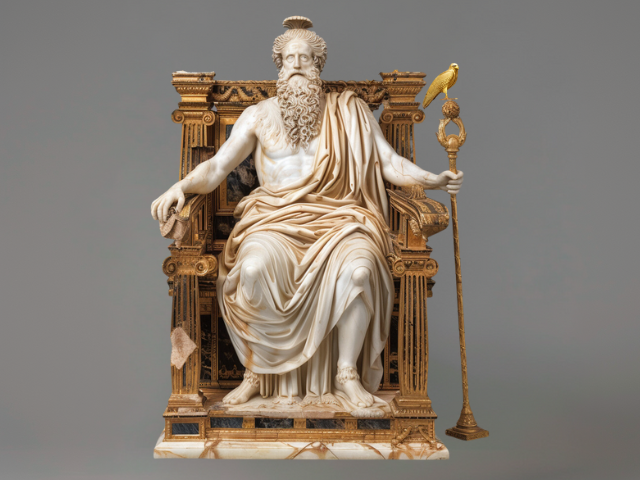
The Statue of Zeus at Olympia, a marvel of ancient Greek craftsmanship, has a rich history steeped in cultural significance and artistic achievement. Crafted in the 5th century BCE, this magnificent statue was not just a religious symbol but also a representation of the pinnacle of Greek artistic expression. The renowned sculptor Phidias, who was also responsible for the Parthenon’s sculptures, undertook the task of bringing this deity to life. He chose ivory and gold to capture Zeus’s divine form, materials that reflected the god’s celestial status and the wealth and power of Olympia. The statue was housed in the Temple of Zeus, a site of pilgrimage for ancient Greeks, showcasing the deep intertwining of religion, art, and society.
This artistic masterpiece stood almost 40 feet tall, embodying not just the physical attributes of the king of gods but also the cultural aspirations of the Greeks. Its creation was a monumental task that involved skilled artisans and resources from across the region, symbolizing a unified Greek identity. The Statue of Zeus at Olympia was more than just a work of art; it was a testament to human creativity, religious devotion, and the societal importance of Olympia as a center for worship and competition. Its legacy, though the statue no longer survives, continues to fascinate historians and art lovers, serving as a reminder of ancient Greece’s grandeur and the enduring power of its cultural achievements.
The design and artistry behind the statue
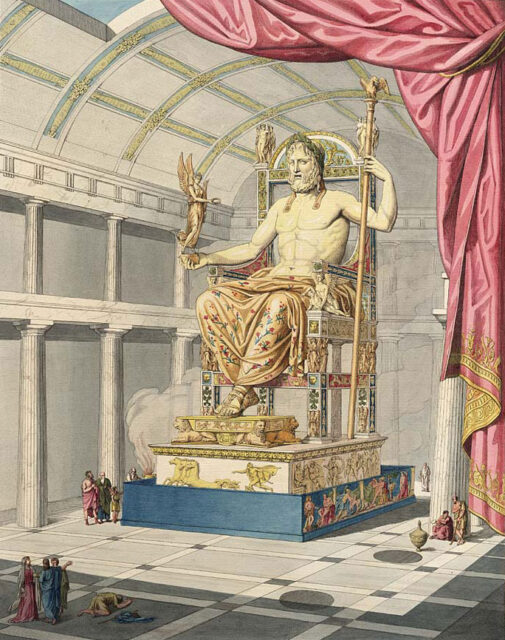
The Statue of Zeus at Olympia stands as a testament to the incredible ingenuity and artistry of the ancient Greeks. Crafted by the famed sculptor Phidias, this monumental statue was not only a religious icon but also a masterpiece of design, embodying the pinnacle of classical artistry. The materials used, including gold and ivory, were chosen for their beauty and durability, showcasing the advanced techniques of the time. The statue depicted Zeus seated on an elaborate cedarwood throne, intricately adorned with gold, ivory, ebony, and precious stones, highlighting the opulence and sophistication of Greek craftsmanship.
Delving deeper into the artistry behind the Statue of Zeus at Olympia, it’s fascinating to consider the symbolic elements incorporated into its design. The figure of Zeus was portrayed with a calm yet majestic demeanor, embodying the divine authority and serene power of the god. His right hand held a small statue of Nike, the goddess of victory, symbolizing success and triumph, while his left hand grasped a scepter with an eagle atop, representing his dominion over the cosmos. This careful integration of symbolism with artistic skill not only reflected the cultural values of the Greeks but also served to inspire awe and reverence among those who viewed it. The statue’s grandeur and intricate details made it one of the most celebrated artistic achievements of the ancient world, illustrating the heights of creativity and innovation attained by Greek civilization.
The Statue of Zeus at Olympia in ancient culture and religion
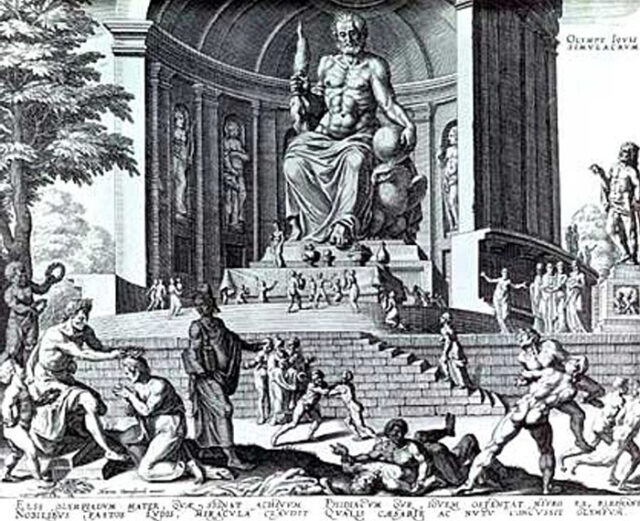
The Statue of Zeus at Olympia wasn’t just a marvel of artistry; it also held profound cultural and religious significance in ancient Greek society. Crafted by the renowned sculptor Phidias, this colossal figure wasn’t merely a representation of the king of the gods but a symbol of the unity and power of the Greek people. Worshippers from all corners of the Hellenic world would journey to Olympia, not just for the famous games but to stand in awe before Zeus, offering prayers and sacrifices in the hopes of earning his favor. This pilgrimage was as much a spiritual journey as it was a testament to the shared beliefs and values that connected the diverse city-states of Greece.
Moreover, the presence of the Statue of Zeus at Olympia within the temple dedicated to him was a testament to the integration of art, religion, and community life in ancient Greece. The statue, adorned with gold and ivory, was not only a religious icon but also a celebration of human achievement and creativity. Festivals and ceremonies held in Zeus’s honor brought individuals together, fostering a sense of belonging and communal identity among participants. It was this blend of divine reverence and human ingenuity that underscored the importance of the Statue of Zeus at Olympia in ancient culture and religion, making it a central figure in both the spiritual and social lives of the Greeks.
The disappearance and legacy of the Statue of Zeus at Olympia
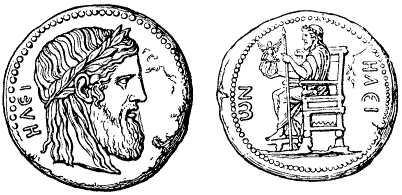
The Statue of Zeus at Olympia, one of the Seven Wonders of the Ancient World, has intrigued historians and archaeologists for centuries, particularly regarding its mysterious disappearance. However, its fate after the decline of the Olympic Sanctuary has been a subject of much speculation. Some accounts suggest that it was transported to Constantinople, where it ultimately perished in a fire in the fifth century AD, yet concrete evidence remains elusive, leaving its end shrouded in mystery.
Despite its physical absence, the legacy of the Statue of Zeus at Olympia endures through literary descriptions, ancient coins, and small-scale replicas discovered in archaeological excavations. These remnants have allowed scholars to piece together its grandeur and significance, providing insight into ancient Greek culture and religious practices. Moreover, the statue’s enduring fame has inspired modern artists and has continued to captivate the imagination of people around the world, serving as a testament to the lasting influence of ancient Greek art and mythology on contemporary society.
Read more: Colossus of Rhodes – The Ancient Wonder That Towered Over Greece
The story of the Statue of Zeus at Olympia, from its creation to its disappearance, remains a fascinating chapter in the history of ancient wonders, reminding us of the transient nature of human achievements and the enduring power of legacy. The statue, crafted by the renowned sculptor Phidias, was not just a religious icon but also a symbol of the unity and power of ancient Greece. Its loss to history is a poignant reminder of the impermanence of human creations, yet it also challenges us to imagine and reconstruct the past, piecing together fragments of information to gain a glimpse of its former glory.
